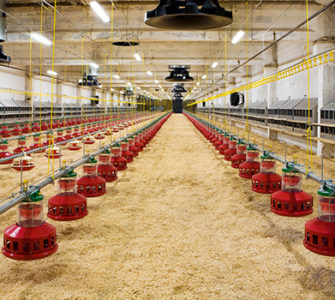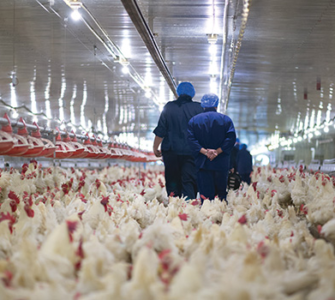Sprinkler systems benefit animal welfare, reduce water use
Sprinkler systems used in conjunction with cool cells during hot summer weather can not only benefit animal welfare, they can dramatically reduce water use, Tom Tabler, PhD, professor, Mississippi State Extension, told Poultry Health Today.
“It’s not necessarily heat alone that kills chickens. It’s a combination of heat and humidity,” Tabler explained.
“With cool cells alone, temperatures are often maintained at 82° F or 83° F (27° C to 28° C) inside the chicken house, even when it’s 100° F (38° C) outside, but humidity is generally 90% or higher.’’
Chickens cool themselves by respiring. If they’re respiring out 100% humidity and they’re breathing back in 90%-humidity air, they have to work hard to cool themselves. “If you can rachet that humidity down to say 40%, 50%, that chicken can gain a lot of traction by breathing out 100% humidity and breathing back in 40% humidity,” he said.
Drier litter, better paw quality
Sprinklers enable producers to run the house temperature higher — as high as 88° F or 90° F (31° C to 32° C). Chickens are comfortably cooled with sprinkling, but the house temperature is hot enough to evaporate water and keep the litter drier compared to houses with lower temperatures and higher humidity — and drier litter improves paw quality, Tabler continued.
“At Mississippi State, we can basically use half the amount of water if we use sprinklers and cool cells in conjunction with one another over what we will use if we’re only using cool cells alone to cool that chicken,” he said.
Installing a sprinkler system is not a big expense, Tabler maintained. There are a few commercial systems available, and they operate on existing line pressure.
“You’ve got a few solenoid valves, a little control box [to program the system] and you’ve got some three-quarter-inch PVC pipe that runs two lines down the house, usually one above this feed line and one above that feed line.” Spinner heads along the pipe throw water out in about a 20-foot diameter, he said.
Differs from foggers
Tabler pointed out that a sprinkler system is different from a fogger system, which increases humidity because it saturates the air with small drops of water. With a sprinkler system, big drops of water are periodically sprinkled on chickens, like raindrops.
He usually runs a sprinkler system every 20 minutes but said that may vary depending on the age and size of chickens and how much heat they’re putting out. Don’t allow birds’ feathers to become saturated, he emphasized.
Sprinklers take advantage of the wind-chill effect from house fans. Tabler likens it to a person jumping in and then out of a creek on a hot summer day.
“If you’ve got any wind blowing at all, you feel pretty good because that wind-chill effect on your wet skin cools you off pretty well. It’s still 100° F (38° C) outside, but you don’t realize it’s 100° F (38° C) outside because that wind chill is bluffing you into thinking that it’s colder. It’s the same process in the chicken house.”
A sprinkler system, however, should not be used until chickens are at least 4.5 to 5 weeks old. Sprinklers used when chickens are small and while there is a lot of empty floor space will wet the floor, he cautioned.
“I wait until those chickens basically cover the floor area and all of that water that those sprinklers are putting out is going on that chicken and not on the floor. And what water is going on that chicken I’m evaporating before that sprinkler system comes on again,” Tabler said.
Hard sell
He acknowledged that convincing producers about the benefits of a sprinkler system and raising house temperatures is a difficult sell but says there are enough data from the experience at Mississippi State to demonstrate the system works when implemented correctly.
“A lot of people begin to panic because we’re spoiled to cool cells. And if that temperature begins to get above 83° F, 84° F (28° C to 29° C), people get worried. But again — if you’ve got low enough humidity, you can ramp that temperature up to 88° F, 90° F (31° C to 32° C).
“Now, you can’t run the house too cool and run sprinklers because if you do you will wet the floor, the chickens will stay damp, and you don’t want that. And you lose the advantage. So, you’ve got to learn to think differently and manage it differently from what you do with a cool-cell system,” Tabler said.
Learn more about Tabler’s experience with sprinkler systems in his Poultry Health Today Expert Advice article.
Posted on September 12, 2019

















